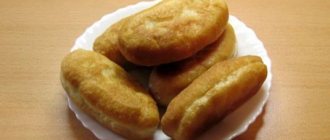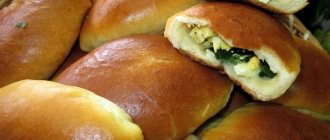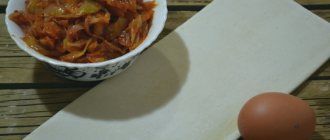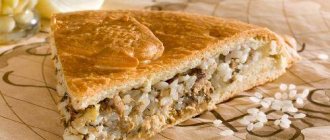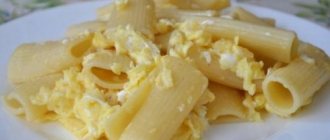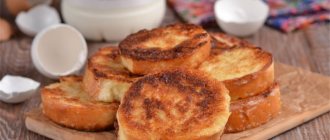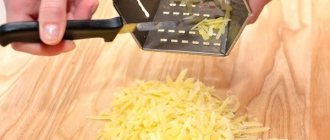Fried yeast dough pies with cabbage and egg
I suggest frying pies from homemade yeast dough with cabbage and eggs. You can use dry or compressed yeast. When choosing flour, give preference to the highest grade with a high degree of gluten. For the filling, young cabbage with thin leaves and country eggs are preferable.
What we need for the pies:
Filling:
- egg – 1 pc.;
- cabbage – 150 g;
- carrots – 0.5 pcs.;
- paprika – 2 g;
- nutmeg – 3 g;
- salt pepper;
- vegetable oil (for frying the filling and pies) – 3-4 tbsp.
Dough:
- salt – 3 g;
- sugar – 5 g;
- dry yeast –6 g;
- vegetable oil – 1 tbsp;
- egg – 1 pc.;
- water – 100 ml;
- flour – 250-270 g.
Quantity: 6 servings
Cooking time: 50 min.
How to fry yeast pies filled with cabbage and eggs in a frying pan
- Pour yeast, salt and sugar into a bowl. Pour in boiled water at room temperature. Stir the mixture and leave for 5 minutes.
- Add vegetable oil and beaten egg.
- Add sifted flour in parts, knead. Cover the bowl with cling film and leave to rise for 30 minutes.
- Grind the carrots on a grater.
- Chop the cabbage and fry along with the carrots until soft.
- Boil the egg, cut into cubes.
- Mix the eggs with the vegetable part, salt, pepper and add pepper and other spices to taste.
- Knead the dough, divide into 6 parts.
- Roll out each part. Place the filling in the center of the flatbread.
- Pinching the edges, form the blanks. Place them seam side down in a frying pan with hot oil. Fry the products in a frying pan on both sides until golden brown over medium heat.
Place the finished pies on a serving plate, add fresh herbs and chopped vegetables. Lush, with a juicy and fragrant filling, they do not go stale for a long time.
Author: Natalya Komarova
Yeast dough recipe
Well, let's get started. I'm preparing yeast starter. In a small saucepan, heat one glass of milk until warm. The milk should not be hot, but pleasantly warm.
I put sugar in the milk and add dry yeast. I stir until the dry powder begins to dissolve little by little.
Then I add half a glass or two heaped tablespoons of flour. I sifted the flour first. Stir until smooth and place in a warm place near the stove. I'll leave it for a while. Let the yeast begin to actively work.
The dough allows you to immediately check the quality of the yeast. If they are little active and the mass does not rise within 20-40 minutes, then the yeast needs to be replaced and a new batch made.
Literally in 20 minutes our dough is ready - that’s how much the cap has already grown. This means the yeast is good and active.
Now I’m gradually moving on to kneading the dough. I also heat the remaining milk until it is warm.
In the meantime, I break the eggs into a bowl and add salt. I mix both components so that the salt begins to dissolve.
You need to be more careful with salt. Too much of it can reduce yeast activity.
Pour one glass of sifted flour into the egg mixture and stir until smooth.
Flour should be added to the mixture gradually, one or half a glass at a time.
When the batch is still not cool, I pour in the fermented yeast. I mix everything and continue adding flour.
Melt the butter over very low heat until it reaches a liquid consistency. To make the process faster, the butter can be cut into smaller pieces.
You need to make sure that it melts at the same temperature and does not boil. When the lump has already reduced by half, it is better to remove it from the heat and give it the opportunity to gradually dissolve in the oily liquid base that has already appeared.
I leave one tablespoon of melted butter, and pour the rest into the batch. I mix it into the flour mixture. I continue to add flour little by little until it becomes difficult to do it with a spoon. Then I start, while still in the bowl, kneading the dough with my hands.
Now I sprinkle flour on the clean table. I put the lump out of the bowl and continue to knead it for 5-8 minutes. By the end of kneading, the dough should not stick to your hands.
At the very end of the kneading, I coat the ball of flour with the remaining butter. I'll remember it a little more and shape it into something like a ball.
I put it back in the bowl, cover it with a towel and put it in a warm place. I leave it for 40-50 minutes to rise.
While our mixture is getting fluffy, I’ll start filling. I clean the cabbage from the top leaves and wash it. I cut off the required amount. I cut it into thin strips.
Pour a little vegetable oil into a heated frying pan. I spread the shredded cabbage. I add salt, red pepper and suneli hops. Not everyone may like this bouquet of spices. You can easily replace it with your favorite one. I mix everything and put it on medium heat. Fry the cabbage until done.
When the cabbage is ready, remove it from the heat and let it cool. I peel hard-boiled eggs. I cut them into small pieces. Pour into the vegetable mixture and stir. The filling is ready.
By this time the dough has already doubled in size. I crush it, releasing carbon dioxide. I roll into a ball again. I return it to the bowl and cover with a towel. I leave it for another half hour or a little more for the next rise.
After half an hour, the dough had already increased approximately four times. I hug him. Now you can work with it.
I divide it into two parts. I leave one part in the bowl. And I roll the second into a thick rope and cut into portions. In the future, one piece will make a wonderful pie. (While I was kneading the dough, it even squeaked.)
I turn each cut piece into balls. The dough does not stick to the table or to your hands. I didn't even flour the table. I leave the round pieces to lie down for a while to rise.
The dough rises and swells quickly. Now you can safely start rolling out each ball.
Now I arm myself with a rolling pin. I roll out each round piece into a flat cake. I put the filling on it and form a pie. I carefully connect it and seal the edges with firm pressure.
You can immediately roll out all the flatbreads and spread the filling on them. This way you will evenly distribute all the filling. There will be enough filling and dough.
I preheat the oven to 180°C. I lightly dusted the baking sheet with flour to be on the safe side. I lay the blanks on it. I leave them. I give them time to distance themselves.
In order for my products to have a ruddy golden appearance, I grease them with beaten egg. And I put it in a hot oven. Bake them for 20-30 minutes at 180°C.
I baked them for 20 minutes. I judge readiness by the browning of both the top and bottom sides.
Try not to overcook the pies in the oven. Otherwise they will be tough and dry out. If you doubt the readiness, it is better to sacrifice one pie, breaking it into two halves. But then you will definitely be sure that the dough is baked.
I remove the baking sheet with the finished pies from the oven. I transfer them to a bowl and cover with a towel. There they will rest and become even softer.
We lay down and rested. Well, now, while they’re still hot, you can enjoy them. I put it on a dish and serve it with tea. By the way, they store well and last a long time. Of course, they don’t stay with us. But this is a note.
My boys are delighted when we take out the finished baked goods. We prepare it little by little. This time they even exceeded their quota. We got 20 pieces. And the pies turned out good. Both plump and soft. Everything is in moderation, and the filling did not disappoint. Delicious. It will come in very handy for tea. How do you prepare the dough for pies? With what filling? Write in the comments.
Author of the publication
offline 2 hours
Kefir pies with cabbage and egg, fried in a frying pan
Great recipe for dough without yeast. You still have to knead it, but the pies cook much faster and turn out airy and soft.
Ingredients:
For the test:
- kefir – 1 glass (250 ml);
- egg - 1 pc.:
- flour – 2 cups (250 ml);
- salt – 1/2 tsp;
- sugar - 1 tbsp;
- soda - 1 tsp.
- vegetable oil - 1 tbsp.
For filling:
- white cabbage - 350 g;
- onion - 1 pc.;
- carrots - 1 pc.;
- egg – 1 pc.;
- vegetable oil - 2 tbsp;
- salt - to taste.
Quantity: 7 pieces
Preparation time: 35 min.
Cooking time: 15 min.

